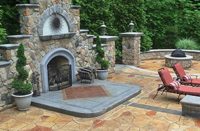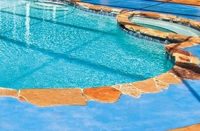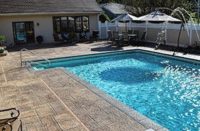Brandon Meeks, president and founder of both Birmingham Concrete and Birmingham Decorative Concrete, chats by phone from a newly constructed 5,300-square-foot building with full HVAC and 20-foot ceilings. His crew poured the footings, concrete slab and sidewalks around it. The property sits on 44 acres of woods and grass near Birmingham, Alabama.
The building and grounds are mostly empty now, but not in Meeks’ mind’s eye. Here he sees classrooms for certified instructors and networking spaces for after-hours socializing, and outdoor grills and campgrounds with electricity and water. More than that, he sees concrete being poured and stamped, stenciled and polished and turned into stunning driveways, walkways, decks and patios by eager students learning the art and craftsmanship of decorative concrete the right way.

That’s in the very near future, according to Meeks. Quite probably as early as the coming autumn. Attendees can be sure they’ll be wearing proper PPE on the job. That’s a critical concern of his.
“My grandfather died from mesothelioma contracted through exposure to asbestos both while he was in the Navy and during his work days as a machinist in a foundry, Meeks says. “If he’d had proper safety equipment, he might still be with us today.”
That loss no doubt helped spur Meeks’ focus on safety in everything his own crews do at both of his companies.
Safety was also a motivating factor to his initial involvement with the local chapter of the American Society of Concrete Contractors. Today, he has an advisory board position on the ASCC’s Decorative Concrete Council (DCC).

He found that membership got him, among other things, access to safety data and literature he could use to make sure his people had proper PPE attire and that he could show evidence of it to OSHA.
Nothing concerns Meeks more than seeing concrete work at sites less concerned with the safety of their people. “You’ve got guys swinging 30-pound chipping hammers in sandals, with no eye protection,” he says.
His crews wear goggles, steel-toed boots, gloves and respirators, whatever the job requires. Personal safety is also the motivating factor behind Camp Concrete, a dream of his for the last three years of a career that’s nearly twenty years long.
Another leading ASCC advantage, from Meeks’ perspective, is the in-depth education benefit. Through ASCC, he’s earned American Concrete Institute (ACI) certification for both concrete flatwork and decorative concrete flatwork.

Visual Design in a More Permanent Medium
Meeks started his work life as a graphic designer creating trade show displays. Then he did sales training for a couple of years. But once he married and had young kids, he wanted to travel less and spend more time with his family.
So, without giving up his passion for visual design, Meeks made the transition to the decorative concrete business in 2005. He figured there was enough high-end residential and commercial work in his hometown that he’d rarely have to stray far from his growing family.
He also loved the permanence of decorative concrete, compared to trade show booths that are torn down at the end of a convention. As he puts it, “In twenty years, I figured I could take my kids to a decorative concrete display and say, ‘See this? This is what I did.’”
Early on, Meeks got contacted by a builder who was developing a major residential subdivision and asked him if he could stamp concrete.
I told him, ‘Of course I can.’ Then I went and figured it out.”
He also learned to pour concrete, but that was out of necessity rather than a chosen career direction. Along about 2008 came the economic downturn we all know now as the Great Recession. Luxury housing and high-end commercial projects were suddenly in very short supply in north central Alabama and elsewhere.
Fortunately, Meeks had a friend who was pouring a lot of concrete for self-storage facilities and could use his help with the flatwork. It certainly wasn’t as sexy as decorative concrete. It was hard, sweaty work, but it got Meeks and his crews through the downturn and gave him a more functional understanding of his substrate of choice. Now he could pour as well as he could stamp and polish.
 |
 |
Work Hard, Play Safe
Over the years, Meeks has been to a lot of workshops and concrete training events. One thing always bothered him about how the events were typically run.
“The students would work hard, train all day, and then get together at a local bar somewhere off-site. Then they’d all drive away to their motels.”
This struck a note with Meeks. Getting together and having a few drinks served as a valuable networking strategy. It also provided a welcome break from the hard days of hands-on learning. Tired students with blood alcohol readings getting in their cars and trucks didn’t sit well with him. They were driving maybe fifteen or twenty miles to their rented spaces after their celebratory breaks.
Thus, Camp Concrete.
In addition to the vast indoor and outdoor workspaces, the facility will have space for a cocktail hour afterwards. It will also provide power and water to support a small community of glamping shelters, RVs, and primitive camping tents.
Comfort will not be sacrificed. The glamping facilities will include queen- to king-size beds, couches, TVs and other amenities.
Students will work at the location at which they network afterwards in a bar that Meeks might pour from concrete, and then retire for the evenings at camping facilities just a few steps away. Safety is, once again, job one.
That’s in the not-so-distant future. More recently, Meeks spearheaded a goal he’d had even since switching from graphic design to concrete design.

Transformation of a ‘Prison Yard’
Remember Meeks’ stated desire to slide into a decorative concrete career so he’d have something stable and transformative to show his kids in 20 years? He made his deadline, with time to spare.
Meeks nominated Leeds High School in Birmingham for the Spring 2023 volunteer project of the DCC. The group accepted his proposal. The school had a central courtyard, which Meeks describes as “looking like a prison yard.” So he led a team of a dozen volunteers from eight states to spend nine days scoring, acid staining and adding lounge benches and even an outdoor teaching space for as many as 30 students.
They etched and acid stained the school’s logo. The group also even added a “sensory path” with vibrant permanent color, lily pads, a bridge and other elements. They added these to maintain the focus and interest of the school’s special needs students, many of whom have attention-deficit disorders.
Meeks knew that the high school needed space restoration because all three of his kids attended there. In fact, daughters Emily and Julia were still students there while their dad and his team brought the formerly dismal courtyard back to new life. Emily got to come onto the worksite and inspect the job’s progress, take pictures and interview some of the volunteers.
“She had to wear full PPE equipment just like everyone else on the job site,” says Emily’s dad.
Well, of course she did.















